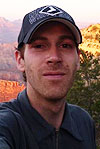Two winners selected for 14th annual URA Thesis Award
Two graduate students working at the Tevatron were selected to receive the URA Thesis Award, honoring them for their research achievements.
Xuebing Bu, a graduate student at the University of Science and Technology of China working on DZero, and Simone Pagan Griso, a graduate student at the Universita Degli Studi di Padova who worked on CDF, are the joint recipients of the 14th annual Universities Research Association Thesis Award.
"Both were excellent for different reasons and we were unable to split between them," said Steve Brice, Fermilab particle physicist and URA Thesis Award committee chair.
 |
|
Xuebing Bu
|
At DZero, Bu developed mathematical algorithms to search for the Higgs boson via its decay to diphotons. When Bu started on the project, no single approach to photon identification in collision data was widely accepted in the field. As co-convener of DZero's electron/photon identification group, Bu led the way in redesigning and unifying the process of photon identification.
Aurelio Juste from IFAE-Barcelona nominated Bu's thesis, titled "Higgs to gamma gamma Search and Direct Photon Pair Production Differential Cross-Section Measurement at D0."
"Bu put in an enormous amount of work to squeeze information out of photons and electrons in the DZero detector," Brice said. "His work will be important for Higgs searches at the LHC."
 |
|
Simone Pagan Griso
|
Pagan Griso received the award for his work on CDF, where he searched for
the Higgs boson decaying to two W bosons. He developed novel techniques for
separating potential signal events into multiple analysis channels based on
their kinematic properties. By isolating events likely associated with specific
Higgs production and background production processes, Pagan Griso was able
to make significant improvements in the overall search sensitivity.
The results of Pagan Griso's thesis, combined with results from DZero, led to the first exclusion of the region 160-170 GeV/c2 from the Higgs boson's allowable mass range. Previously, physicists' calculations had placed the Higgs boson in a mass range lower than 185 GeV/c2.
Eric James, Fermilab particle physicist, nominated Pagan Griso's thesis, titled "Searches for a High-Mass Higgs Boson Produced in p-pbar Collisions at sqrt(s) = 1.96 TeV."
"This was a well-written thesis with real analysis innovations for a different type of Higgs search," Brice said. "Pagan Griso's thesis is a model of clarity and detail that shows a deep understanding of his material."
Both awardees expressed pride and gratitude for the opportunity to work on the Tevatron during the last years of its lifetime.
"The Tevatron has been around for so long and it's amazing because it's still producing some of the best results," Pagan Griso said.
Bu and Pagan Griso will split a $3,500 prize funded by the Universities Research Association. They will receive their awards at 1:45 p.m. today as part of the annual Users' Meeting. After the award presentation, the awardees will give brief talks about their thesis research.
— Christine Herman
|